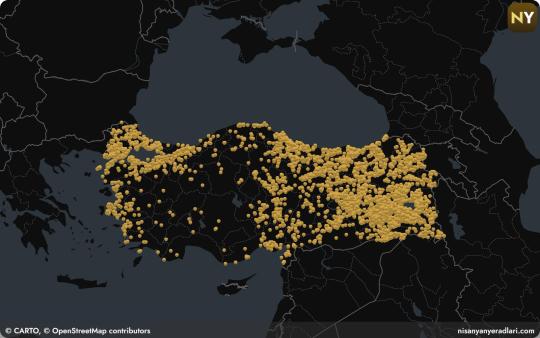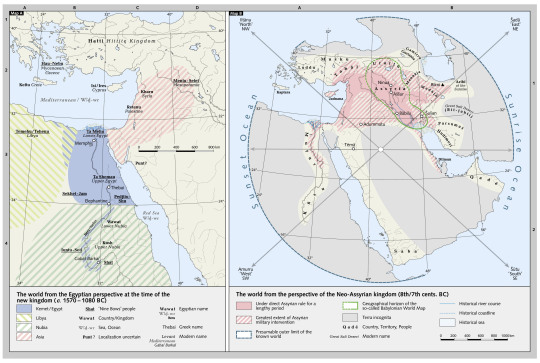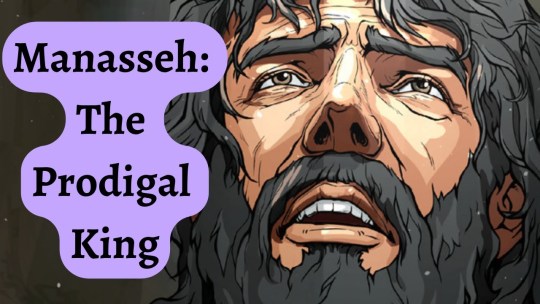#assyrians
Text
Also leaving this here since today is the Remembrance Day for victims of the Anfal genocide.
Where Saddam Hussein (with the help of the MEK) and his cronies slaughtered hundreds of thousands of Kurds and Assyrians (and other minorities) in Iraq near the end of the Iran-Iraq war.
I posted about it earlier this year not too long ago.
Feel free to reblog.
#dougie rambles#news#political crap#middle east#mesopotamia#iraq#assyria#bethnahrin#kurdistan#kurds#assyrians#Assyrian people#genocide#anfal genocide#forgotten history#remembrance#commemoration#anniversary#Iran-Iraq war#saddam hussein#war crimes#terrorism#reblog this#reblog the shit out of this#feel free to reblog
46 notes
·
View notes
Photo

Map of settlements in the Republic of Türkiye that had an Armenian, Assyrian or Greek Orthodox population in the early 20th century according to Nişanyan Yeradları
96 notes
·
View notes
Text
The tunnel of Hezekiah.
Water tunnel carved under the City of David in Jerusalem in ancient times. Its popular name is due to the most common hypothesis of its origin, namely, that it dates from the reign of Hezekiah.
The tunnel leads from the Gihon Spring to the Pool of Siloam. If indeed built under Hezekiah, it dates to a time when Jerusalem was preparing for an impending siege by the Assyrians, led by Sennacherib.
Since the Gihon Spring was already protected by a massive tower and was included in the city's defensive wall system, Jerusalem seems to have been supplied with enough water in case of siege even without this tunnel. The curving tunnel is 533 m., According to the Siloam inscription, the tunnel was excavated by two teams, one starting at each end of the tunnel and then meeting in the middle.

#jerusalem#israel#secular-jew#jewish#judaism#israeli#diaspora#secular jew#secularjew#islam#hezekiah#tunnels#kind David#pool of siloam#Assyrians
25 notes
·
View notes
Text
Is Mesopotamia the true “Cradle of Civilization”? It produced some of the ancient world’s most advanced civilizations- the Sumerians, Assyrians, Persians, and Babylonians.
17 notes
·
View notes
Text
Deity Dagan
Originally a god of West Semitic speakers from the Levant, but worshipped widely throughout the Near East, including Mesopotamia.
Deity of grain, as well as its cultivation and storage. Indeed, the common word for "grain" in Ugaritic and Hebrew is dagan. According to one Sumerian tradition and to the much later Philo of Byblos, Dagan invented the plow. In the north, he was sometimes identified with Adad. Thus, he may have had some of the characteristics of a storm god. In one tradition his wife was Ishara, in another Salas, usually wife of Adad. Salas was originally a goddess of the Hurrians. Dagan also had netherworld connections. According to an Assyrian composition, he was a judge of the dead in the lower world, serving with Nergal and Misa-ru(m), the god of justice. A tradition going back at least to the fourth century BCE identified Dagan as a fish god, but it is almost certainly incorrect, presumably having been based upon a false etymology that interpreted the element "Dag" in Dagan as deriving from the Hebrew word dag "fish."
The earliest mentions of him come from texts that indicate that, in Early Dynastic times, Dagan was worshipped at Ebla. Dagan was taken into the Sumerian pantheon quite early as a minor god in the circle of Enlil at Nip-pur. Kings of the Old Akkadian peri-od, including Sargon and Narām-Sin, credited much of their success as conquerors to Dagan. Sargon recorded that he "prostrated (himself in prayer before Dagan in Tutul [sic]" (Oppen-heim, ANET: 268). At the same time, he gave to the god a large area of the country he had just conquered, including Mari, Ebla, and larmuti in western Syria. A number of letters from the Mari archives, dated mainly to the reign of Zimri-Lim, record that Dagãn was a source of divine revela-tion. The letters reported prophetic dreams, a number of which came from Dagan, conveyed by his prophets and ecstatics. In his law code, Hammu-rapi credits Dagan with helping him subdue settlements along the Euphrates.
The Assyrian king Samsi-Adad I commissioned a temple for him at Terqa, upstream from Mari, where funeral rites for the Mari Dynasty took place.
In the Old Babylonian period, kings of the Amorites erected temples for Dagan at Isin and Ur. In the Anzû(m) myth, Dagan was favorably coupled with Anu(m). At Ugarit Dagan was closely associated with, if not equated to, the supreme god El/I(u). Although he is mentioned in the mythic compositions of Ugarit as the father of the storm god Ba'lu/ Had(d)ad, Dagan plays only a very minor role. His popularity is indicated by his importance in offering and god lists, one of which places him third, after the two chief gods and before the active and powerful god Ba'lu/ Had(d)ad. Dagan is attested in Ugaritic theophoric names. In Ugaritic texts the god is often referred to as "Dagan of Tuttul." It might also be the case that one of the two major temples of the city of Ugarit was dedicated to him, and he might there have been identified with the chief god I(u) / El.
Festivals for Dagãn took place at Ter-ga and Tuttul, both of which were cult centers of the god. He was certainly worshipped at Ebla and also at Mari.
At Mari, in Old Babylonian times, he appears as fourth deity on a god list; that is, he was very important. He was venerated also at Emar. There a "Sacred Marriage" ritual between Dagan and the goddess Nin-kur was celebrated.
At the same city, a festival was held in honor of "Dagan-Lord-of-the-Cattle," at which the herds of cattle and prob. ably sheep were blessed.
According to the Hebrew Bible, Dagan was the national god of the Philistines. I Samuel:5-6 tells of the capture of the Ark of the Covenant by the Philistines. It was customary in the Ancient Near East for the conquerors to carry off the deity statues of the conquered to mark the surrender not only of the people, but also of their deities.
So the Philistines took the Ark, the symbol of the god of the Israelites, into the temple of Dagan at Ashdod. Since the Israelites had no statues of their deity, the much revered Ark was an obvious substitute. In this way, the Philistines marked the submission of the Israelite god to Dagan. However, on the next day, the people of Ashdod found the statue of Dagan lying face down in front of the Ark. The following day the same thing happened except that the head and hands of Dagan's statue lay broken on the temple threshold. This biblical account seems to be an etiology for a practice of the priests of the temple of Dagan at Ashdod, for it states that for this reason it is the custom of the priests of Dagan not to tread on the threshold as they enter the temple of Dagan. The best-known of the biblical stories that mention Dagan is in Judges 16, the tale of Samson and Delilah. After Delilah arranged for the Philistines of Gaza to capture Samson, they blinded him, shackled him, and made him a slave at a mill. During a festival to Dagan, the Philistines took Samson to be exhibited in Dagan's temple, where thou sands of Philistines had gathered for the celebrations. After praying to the Israelite god, the now long haired Samson got back his old strength. By pushing against two central pillars, he brought the temple crashing down on himself and on more Philistines than he had killed in his whole lifetime of killing Philistines.
— From a Handbook to Ancient Near Eastern Gods & Goddesses by Frayne & Stuckey page 67-69
#pagan#polytheism#levpag#philistines#israelites#canaanites#assyrians#1 samuel#tanakh#mesopotamians#dagan#dagan deity#deity#god#quote#sumerian polytheism#levant#ancient near east#landof2rivers#quote pile#put this in text for someone so thought id post it#eblaite#ebla
8 notes
·
View notes
Photo

Call him ‘Maher-shalal-hash-baz
1 The Lord also told me, “Take a large tablet and write on it with a stylus pen, ‘For Maher-shalal-hash-baz’. 2 Then I will call Uriah the priest and Jeberechiah’s son Zechariah as reliable witnesses to testify on my behalf.”
3 After this, I was intimate with the prophetess and she conceived. Later, she bore a son, and then the Lord told me, “Call him ‘Maher-shalal-hash-baz,’ 4 for before the young lad knows how to call out to his father or mother, the wealth of Damascus and the plunder of Samaria will be carried off by the king of Assyria.”
Invasion by Assyria
5 The Lord spoke to me again: 6 “Because this people have rejected the gently-flowing waters of Shiloah, and because they keep rejoicing in Rezin and Remaliah’s son, 7 watch out! The Lord God is about to bring the flood waters of the Euphrates River against them, mighty and strong.
“It’s the king of Assyria and all of his arrogance! He will rise over all of the river’s channels and run over all of its banks. 8 He will sweep on into Judah, overflowing as he passes through, like flood waters reaching up to a person’s neck. His outstretched wings will flow as wide as your land, O Immanuel!”
9
“Band together, you peoples,
but be shattered!
Listen, all you distant countries!
Strap on your armor,
but be shattered.
10
Take counsel together,
but it will all be for nothing;
go ahead and talk,
but it will all be for nothing,
for God is with us.”
Waiting on God
11 For this is what the Lord spoke to me, as his forceful hand was resting on me, and as he was warning me not to live the way this people were living:
12
“Don’t call conspiracy everything
that this people calls conspiracy,
and don’t fear what they fear,
or live in terror.
13
The Lord of the Heavenly Armies—
he’s the one you are to regard as holy.
Let him be the one whom you fear,
and let him be the one before whom you stand in terror!
14
Then he will be a sanctuary,
but for both houses of Israel
he’ll also be a stone with which someone strikes himself,
a rock one stumbles over,
a trap and a snare to those who live in Jerusalem.
15
Many will stumble on them;
They’ll fall and be broken;
They’ll be snared and captured.
16
“Bind up the testimony,
and seal up the teaching among my disciples.
17
I’ll wait for the Lord,
who is hiding his face from the house of Jacob,
and I’ll put my trust in him.
18
Watch out! I and the children
whom the Lord has given me
are a sign and a wonder in Israel
from the Lord of the Heavenly Armies,
who resides on Mount Zion.”
Rejecting Occultic Wisdom
19
“So when they advise you,
‘Ask the mediums your questions,
and quiz the spiritists who chirp and mutter,’
shouldn’t a people instead be consulting their God—
and not the dead—
on behalf of those who are living
20
for instruction and for testimony?
Surely they are speaking like this
because the truth hasn’t dawned on them.
21
“They’ll pass through the land,
while[w] greatly distressed and hungry.
When they are hungry,
they’ll become enraged,
and they’ll curse their king and their god.
They’ll turn their faces upwards,
22
or they’ll look toward the earth,
but they’ll see only distress and darkness,
the gloom that comes from anguish,
and then they’ll be thrown into total darkness.”
— Isaiah 8 | International Standard Version (ISV)
The International Standard Version of the Holy Bible Copyright © 1995-2014 by ISV Foundation. All Rights Reserved internationally.
Cross References: Genesis 41:24; Exodus 20:20; Leviticus 24:11; 1 Kings 18:46; 2 Kings 16:10-11; Isaiah 1:10; Isaiah 7:8-9; Isaiah 7:14; Isaiah 17:12; Isaiah 29:11-12; Isaiah 30:8; Jeremiah 20:3; Matthew 1:23; Matthew 21:44; Luke 2:34; Luke 13:4; Luke 20:18; Luke 24:27; Acts 16:16; 1 Peter 3:14-15; Revelation 16:10; Revelation 17:15
#Isaiah's son#prophecy#Assyrians#invasion#call#fear#God#darkness#light#Isaiah 8#Book of Isaiah#Old Testament#ISV#International Standard Version Bible#ISV Foundation
18 notes
·
View notes
Text
The Anunnaki Conspiracy
The ancient Sumerians, Akkadians, Assyrians, and Babylonians worshipped what they called "the Anunnaki", but who were the Anunnaki really? According to one conspiracy theory, the Anunnaki were an alien race of refugees escaping their own planet to mine for gold and other precious metals on Earth. Did the Anunnaki enslave humans to build the pyramids and other ancient landmarks? You be the judge.
#The Anunnaki Conspiracy#Let's Get Haunted#Anunnaki#Sumerians#Akkadians#Assyrians#Babylonians#Spotify
4 notes
·
View notes
Text
Egyptian Culture and Religion's Influence on Other Beliefs
Did you know that the worship of Isis and Osiris may have contributed to the early Christianity?
IN THIS ARTICLE, read about religions & systems influenced by Ancient Egypt.
#EgyptianCulture #ReligiousInfluence #IsisAndOsiris #AncientHistory 🏛️
Egyptian culture and religion had a profound influence on many other religions and cultures throughout history. From as early as predynastic times, Nubia was influenced by Egyptian culture and religion, while Syria was impacted in the 3rd millennium BCE. The New Kingdom of Egypt was very receptive to Middle Eastern cults, and Egyptian medical and magical expertise was highly regarded by the…

View On WordPress
#Africa#Assyrians#Babylonians#Christianity#culture#diaspora#egypt#Egyptian#gnosticism#Hermetism#Jewish#Manichaeism#Neoplatonism#Nubia
2 notes
·
View notes
Text
So-called anti imperialists get weirdly bitchy when you suggest self-determination for certain people groups.
Especially if it’s the Kurds, the Assyrians, Armenians, the Tibetans (that’s when the tankies show up), or the Circassians (or pretty much any other indigenous folks living under Russian rule like the Chuvash or the Buryats (among others)).
Talk about double standards.
#dougie rambles#personal stuff#vent post#political crap#double standards#indigenous peoples#self determination#kurds#assyrians#Assyrian people#Tibetans#Circassians#kurdistan#assyria#bethnahrin#tibet#circassia#leftism#decolonization#anti imperialism
117 notes
·
View notes
Photo

The world according to ancient Egyptians and Assyrians
by Renate Müller-Wollermann and Andreas Fuchs
108 notes
·
View notes
Text
Archaeologists have discovered vast Roman-era structures under Zerzevan Castle in Turkey, capable of housing thousands of people!
46 notes
·
View notes
Text
King Manasseh

View On WordPress
0 notes
Text
Exploring World Civilizations at the British Museum
I was overwhelmed with excitement as I entered each of the rooms at the British Museum. I have never before seen so much history represented in one place. Unprepared for the amazing relics and archaeological objects spanning thousands of years, I was excited for the opportunity to glimpse into the lives and cultures of so many ancient civilizations. Established in 1753, the British Museum is…

View On WordPress
#Acropolis#Africa#ancient Egyptian#Ancient Greece#Ancient Rome#archaeological digs#archaeological objects#archaeologist#Architrave of Ptahshepses#artwork#Ashurnasirpal II at Nimrud#Assyria#Assyrians#Athena#Babylonians#body preservation#British Museum#bronze cat#bull#carved panels#chariot#civilizations#Colossal Statue of Ramesses II#colossal statues#Coptic art#cuneiform writing#earthly possessions of the dead#Egypt#Egyptian Exhibit#Egyptian hieroglyphics
0 notes
Text
The antichrist. How, then, do we fit the Roman Empire into this mix? Daniel 9:26 and a few other verses.
In the previous post, I referred to Daniel describing the statue, with the head of gold, to Nebuchadnezzar. He tells Nebuchadnezzar that he is the head of gold. Both the silver and the bronze are referred to as inferior kingdoms, and though history lends a hand and gives us an identification of the Persian empire (technically the Medo-Persian empire) and the Grecian/Macedonian empire initiated…
View On WordPress
#Assyrians#Bible#Christ#city#come#Daniel&039;s prophecies#destroy#empire#end times#fourth kingdom#God#hope#iron#Jesus#Jews#kingdoms#last days#Nebuchadnezzar#people#prince#prophecy#Rome#sanctuary#Scripture#Titus
0 notes
Text
The antichrist. How, then, do we fit the Roman Empire into this mix? Daniel 9:26 and a few other verses.
In the previous post, I referred to Daniel describing the statue, with the head of gold, to Nebuchadnezzar. He tells Nebuchadnezzar that he is the head of gold. Both the silver and the bronze are referred to as inferior kingdoms, and though history lends a hand and gives us an identification of the Persian empire (technically the Medo-Persian empire) and the Grecian/Macedonian empire initiated…
View On WordPress
#Assyrians#Bible#Christ#city#come#Daniel&039;s prophecies#destroy#empire#end times#fourth kingdom#God#hope#iron#Jesus#Jews#kingdoms#last days#Nebuchadnezzar#people#prince#prophecy#Rome#sanctuary#Scripture#Titus
0 notes